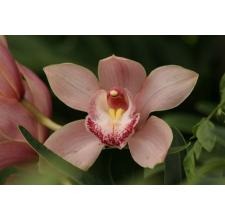Orchids, prized for their ornate flowers, are often grown as houseplants. These perennial flowers bloom in nearly every color and some also have spots or stripes on their petals. Many varieties of orchids are available, including those with variegated leaves and those with aromatic flowers. Orchids grow in two types—those that grow in soil and those that grow high up in trees. Most orchids grown in the home are planted in soil. Maintaining the beauty of your orchid requires proper care, which may differ between orchid varieties.
- Difficulty:
- Moderately Easy
Instructions
things you’ll need:
- Tray
- Pebbles
- Spray bottle
- Fertilizer
- Pot
- Potting media
- Place the orchid plant in a south- or east-facing window. Move the orchid to a shadier location if the leaves begin turning yellow, and to a higher light location if the foliage turns deep green and the plant fails to flower.
- Water orchids when the top 1 inch of planting media feels dry to the touch. Water from the top of the pot until the excess moisture drains freely from the bottom. Orchids must be irrigated with water warmer than 50 degrees Fahrenheit, advises the University of Tennessee Extension.
- Fill a tray with pebbles and add water until the water level sits just beneath the top of the pebbles. Set the orchid pot on top the pebbles so that the evaporating water provides humidity to the plant. Mist the orchid’s foliage with water each morning to provide additional humidity.
- Fertilize orchids once a month with a soluble orchid fertilizer, following the label application rate for the variety of orchid you are growing. Alternately, dilute a 10-10-10 or other balanced fertilizer to one-fourth its strength.
- Repot orchids every two years or when the plant begins outgrowing its pot. Use a pot that is 2 inches larger in diameter than the old pot. Remove the old potting media from the orchid’s roots, then rinse off any remaining soil under warm running water. Use bark, peat moss or other soil-less media. Plant the orchid to the same depth in the new pot that it was at in its previous pot.
Tips & Warnings
-
Each orchid variety has different care requirements, so always verify your plant’s exact needs as detailed on the plant label.
-
Repot orchids after they finish flowering for the season. Repotting too early or too late may inhibit blooming.
-
The high-humidity conditions required for orchids may led to fungal problems. Provide air circulation with a fan or open window to help prevent this.


Deprecated: strpos(): Passing null to parameter #1 ($haystack) of type string is deprecated in /home/agriviek8Qv/agriviet.net/public_html/wp-includes/comment-template.php on line 2522